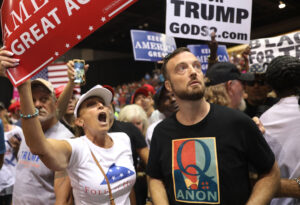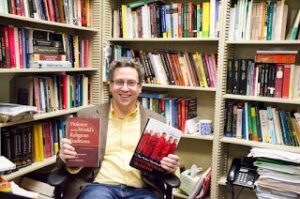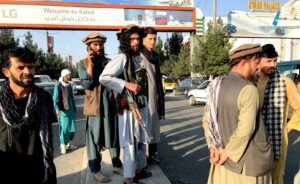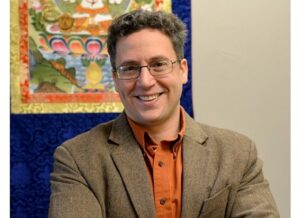
Picture: Taliban entering Kabul August 15, 2021
This essay was posted in English and Polish translation on the website of the Warsaw news magazine Najwazniejsze.
In contrast to Iraq, the U.S. invasion and occupation of Afghanistan beginning in October 2001 is often regarded as the good war. Iraq was the bad war, the unnecessary war in many people’s estimation.
But the sudden though inevitable collapse of the Afghan government and the resurgent Taliban control has raised new questions about why the U.S. military went into the country in the first place, and what in twenty years was accomplished. Was Afghanistan also an unnecessary war?
In the days after the tumultuous events of September 11, 2001, there seemed to be no question is the minds of most sensitive people around the world that the perpetrators of this hideous act needed to be caught and brought to justice. When it became clear that the Taliban regime in Afghanistan had played a role in housing Osama bin Laden and other leaders of the global jihadi movement who had their base of operation in the country, it seemed obvious to many that the regime itself had to be confronted.
Though no one had ever accused the Afghan leaders of being directly involved in the planning and conduct of the terrorist act, they were presumed to be guilty of willingly harboring terrorists. Moreover, the Taliban was a harsh extremist regime with very little international support. Only three countries in the world had extended it official recognition before 9/11 – Saudi Arabia, the United Arab Emirates, and Pakistan – and after the attacks even these few ties were severed. Thus, it seemed, no one was willing to come to Afghanistan’s defense as the U.S. military prepared to invade the country.
Yet the invasion of Afghanistan has raised some interesting questions. Was the invasion necessary, and did the U.S. expect that their presence would enable Afghanis to adopt a different kind of regime?
The Taliban was one of several contending Islamic parties in the aftermath of the fall of the Soviet-backed regime that had ruled the country since the Saur Revolution brought a socialist form of government to power in 1978. After a long and debilitating struggle between the Soviet-backed Afghan socialist regime and the Islamic resistance forces – the mujahadin (“fighters”) – the Soviet Union withdrew its support in 1989. The regime of Mohammad Najibullah was soon toppled.
Fighters who had come to join the mujahadin from throughout the Islamic world returned to their own countries and to expatriate communities in Europe and the United States, having been trained in guerrilla warfare and fired with rebellious zeal. Some of these became the terrorists of the new jihadi struggle against the secular governments backed by Europe and the United States, and changed the course of international relations in the post-Cold War world. These mujahadin-hardened fighters included the Saudi militant Osama bin Laden whose organization, al Qaeda (“the base”) was formed during the Afghan-Soviet war.
In the vacuum of power in Afghanistan, a new militant group was taking shape. It was based on former mujahadin militia, but with a more hard-core and strident religious ideological framework. It was called the Taliban, and it quickly emerged as a significant new force.
Taliban literally means “student,” and refers to the origins of the movement: young men who had attended madrassas, or Muslim schools, in the Pashtun-dominated areas of southern and eastern Afghanistan and of the Baluchistan and North-West Frontier provinces of Pakistan. The leader of the movement, Mullah Mohammed Omar, came from a village near Kandahar, attended a religious school – a madrassa – and served as a mullah. He was missing one eye, which he lost in the resistance struggle against the Soviet occupation of Afghanistan. He is said to have never flown on a plane and was uneasy around foreigners.
Though the Taliban was best known outside of Afghanistan for its religious conservatism, the main differences between it and the other religiously conservative groups in the country, such as the Northern Alliance headed by Ahmed Shah Massoud, were ethnic. Massoud and most of his followers were Tajik, and Mullah Omar and his Taliban cadres were Pashtun (Pathan). Mullah Omar was also distinguished by his effective military strength, rumored to have been aided by elements of the Pakistan intelligence agency.
By 1995 Taliban forces were able to capture the capital, Kabul. In 1997 Omar renamed the country the Islamic Emirate of Afghanistan. In August 1998 almost all of the last outposts of opposition in northern Afghanistan crumbled to his control, though the forces of the Northern Alliance led by Massoud fought on. Massoud’s armies were at the forefront of the US-based military conquest of the Taliban in 2001, though Massoud himself had been killed, most likely by Osama bin Laden’s cadres, days before the attack on the World Trade Center and the Pentagon. It is notable that in the August 2021 blitzkrieg that solidified the Taliban’s renewed power, they quickly captured the northern region, thereby diffusing the possibility of a Tajik-based opposition to the Pashtun Taliban militia.
Shortly after the Taliban had gained control of the country in 1996, bin Laden, along with his Egyptian colleague, Ayman al-Zawahiri, and some two hundred of their band of jihadi warriors returned to their old base in Afghanistan. Bin Laden had been abruptly asked to leave his headquarters in Sudan, and thought that the Taliban would provide a more hospitable field of operations. His hopes were fulfilled, and Afghanistan turned out to be a friendly platform for bin Laden and Zawahiri to launch a campaign of global jihadi warfare.
Bin Laden soon ingratiated himself with the leader, Mullah Omar, showering him with gifts and more – some say that he arranged the marriage of one of his daughters to the Taliban leader. Bin Laden and al Zawahiri provided training for their cadres in the old Tora Bora headquarters left-over from the Afghan-Soviet war. They were able to communicate with their operatives and supporters over the world by utilizing new communication devices such as radio telephones and the internet. One of bin Laden’s first acts in 1996 was to release a statement, “A Declaration of Jihad Against the American Occupation of the Land of the Two Holy Sanctuaries.” The land of the two holy places referred to Saudi Arabia, where both Mecca and Medina are located, and the presence of American military bases amounted to an occupation, in bin Laden’s frame of reference.
Two years later, in 1998, bin Laden and Zawahiri, along with Khalid Shaikh Mohammad and other militants from Pakistan, Bangladesh, and Egypt, proclaimed a World Islamic Front against the “Crusaders and Zionists” – the United States, Europe, and Israel. Though the mujahidin struggle in the Afghan-Soviet war in the 1980s was arguably one of the first chapters in global jihad, the 1998 proclamation helped to launch an expanded international campaign of violence. The declaration was issued as a fatwa—a religious edict. It implored Muslims “to kill the Americans and their allies, civilians and military,” as “an individual duty” in any country “in which it is possible to do it,” in order to liberate the Dome of the Rock and the al-Aqsa mosque in Jerusalem, to free the land of the holy places – Saudi Arabia – from foreign forces, and to remove the American military from all Islamic lands, “defeated and unable to threaten any Muslim.” Hence this fatwa gave an ideological justification for an international network to respond to what it described as a global scheme of America and the West to control and denigrate Islamic society.
Within a few months of the proclamation, in August 1998, the al Qaeda network from its base in Afghanistan was able to carry out a spectacular pair of bombings almost simultaneously on U.S. embassies in two African countries, Kenya and Tanzania. Over 200 were killed and many more injured, many of them Africans speared by falling glass from high-rise buildings adjacent to the shattered embassies. Within days, U.S. President Bill Clinton proclaimed that bin Laden and the “Islamic Army Organization” were responsible for the bombings. He ordered a military raid on an al Qaeda camp in Afghanistan, seeking but failing to kill bin Laden and his inner circle. In October 2000, Bin Laden’s network was associated with a brazen attack on the American navy vessel, the U.S.S. Cole, by a suicide squad of jihadi activists as the U.S. Navy guided missile destroyer was docked in the Aden harbor in Yemen.
The attacks on 9/11, however, created a whole new level of engagement and reprisal. Almost immediately, members of the jihadi movement in general and Osama bin Laden’s al Qaeda network in particular were the prime suspects. Mohammad Attah, who was on the first plane to crash into the World Trade Center towers, was quickly identified as one of the leaders of the operation. Papers in his luggage, which did not make it on the transfer from his earlier flight from Portland Maine to Logan Airport in Boston, identified all nineteen of the hijackers. Most were from Saudi Arabia. Attah, however, was an Egyptian who had lived in Germany. He is said to have come under the influence of radical Islam in Europe and to have met Osama bin Laden in 1999. He then received his mission to participate in what was called by jihadi leaders as the “Planes Project.”
On September 20, 2001, President George W. Bush accused the Taliban of harboring al Qaeda terrorists. He delivered a non-negotiable ultimatum demanding that the Taliban government do five things: hand over Osama bin Laden and other al Qaeda leaders to the United States for prosecution; release all foreign nationals, including Americans, “unjustly imprisoned” in Afghanistan; destroy bin Laden’s terrorist training camps in the country; allow US inspectors into Afghanistan to make sure that the camps were destroyed; and “protect all journalists, diplomats, and aid workers” in Afghanistan.
Interestingly, the ultimatum included two items (the release of political prisoners and protection of journalists) that were not directly related to al Qaeda. But it is unlikely that the Taliban would have accepted the demands even if they were limited to what were regarded as terrorist operations. The Afghan government rejected Bush’s demands, saying that they would hold a trial for bin Laden if the US offered any evidence of his complicity in the attacks. At the same time, the Grand Islamic Council of Afghanistan – a convocation of the leading clerics in the country – met in response to the Taliban’s request for their advice on how the Afghan government should respond. The Taliban’s Mullah Omar was likely uncertain what to do in this situation, in part because he was almost completely ignorant of affairs outside his own country and did not understand what the collapse of some building far away had to do with him. Hence he sought his clerical convocation for guidance.
Perhaps to the Taliban leadership’s surprise, the convocation suggested that Osama bin Laden and his foreign militants immediately leave the country. News reports indicated that the Taliban leader, Mullah Omar, was considering the recommendation and would likely have accepted it if he had an indication from Washington that this would be sufficient to keep the US from invading his country. The response from the White House was immediate and negative, however, saying that it would not be sufficient to allow bin Laden to leave Afghanistan only to slip into hiding in another country.
The Taliban government then offered another solution. It would remove bin Laden from Afghanistan under guard in order for him to stand trial in a neutral, third party country (not specified) if the United States would provide evidence that Osama bin Laden was indeed implicated in the attacks. Although this proposal seems reasonable, by the time the Taliban leadership suggested it the matter was moot, since the United States military had already attacked the country and were attempting to destroy bin Laden’s likely hideouts and forcibly remove the Taliban from office.
The combined efforts of American military air strikes and the revived forces of the Northern Alliance caused the Taliban regime to crumble at the end of 2001. The Taliban central regime fell quickly, in part because tribal war lords in Afghan’s regional outposts withdrew their support from what they perceived to be a losing situation—which is largely what happened in the August 2021 collapse of the American-supported Afghan regime. When the Taliban fled from Kabul on November 12, 2001, even members of the Taliban’s own ethnic community, Pushtun, celebrated as if the country had been liberated from an evil oppressive rule, though clearly no government since then has been able to gained the stable confidence of the Afghan people.
The Bush regime clearly had been determined to topple the Taliban regime regardless of whether or not they banished bin Laden from the country or released him into the hands of a third-party nation for a trial. It regarded the Taliban not only as an accomplice of Osama bin Laden but also as a kind of terrorist movement in its own right.
No matter that evidence was never given at the time for bin Laden’s complicity in the 9/11 attack. In fact it might have been difficult for the US to produce such documentation without revealing its intelligence sources. Besides, the official 9/11 Commission Report identified another jihadi militant, Khalid Shaikh Mohammad, based in Pakistan, as the chief architect behind 9/11, not bin Laden. Nonetheless, at the time the dominant position within US leadership circles was that the Taliban was implicated in the 9/11 attack. The most important link in the minds of many who regarded the Afghan invasion as justified was a conceptual one: the notion that the Taliban and al Qaeda were essentially the same kind of thing.
Many have assumed that a radical Islamic regime like the Taliban was terrorist by its very nature. Therefore, whether or not there was an al Qaeda link, toppling such a radical religious regime was morally warranted. It is an interesting moral assumption and a problematic one.
There is no question that Afghanistan was ruled by an unsavory band of leaders. What frightened people about the Taliban was not only its reliance on brutal exercises of violence as a way of controlling its citizenry but also the restrictions on civil liberties that gave the government the appearance of enslaving its populace. Even if the darkest assessments of the Taliban’s harsh rule were true, however, the question remains as to whether these would be sufficient reasons for an external invasion to liberate the country. Part of the answer to that question is the degree to which one thinks a religious regime of this sort is capable of internal change without the necessity for an invasion from outside.
The diversity of political positions within the Islamic Republic of Iran gives some indication that even a rather rigid religious regime is indeed capable of flexibility and perhaps significant change on its own. Muslim militants in other parts of the world – including Sheik Ahmed Yassin in Palestine and Qazi Turadqhonqodz in Tajikistan – have disagreed with Ayotollah Khomeini and rejected many of his positions. Other post-revolution leaders in Iran, including Mohammad Khatami, Akbar Hashemi Rafsanjani, and Hassan Rouhani have been considerably more moderate than the extremists. Saudi Arabia is another hard-line autocratic country that seems to tolerate a certain degree of dissention and liberal lifestyles, at least in private.
The leaders of the Taliban claim that now that they are in charge they want to create a stable respectable government, albeit one with strong Muslim religious limitations. We will see if this promise is fulfilled. But if Afghanistan does turn out to be like Iran or Saudi Arabia or one of the Gulf State Emirates, the question is whether the US can live with it. And if so, whether it accepts that its twenty years of attempts to transform Afghanistan have at least in part succeeded.









